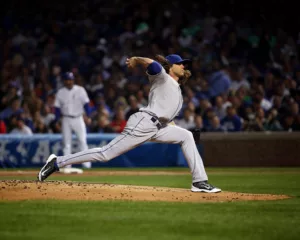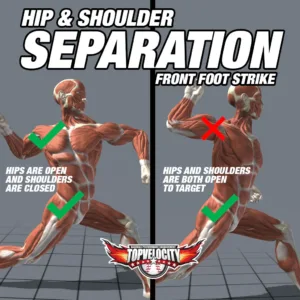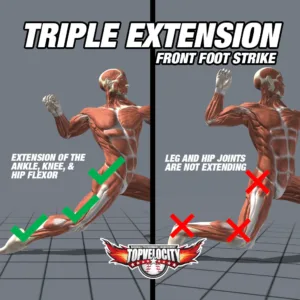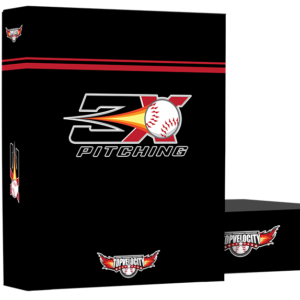 How to Throw Baseball Properly is a coveted skill in the sports world, especially for those aspiring to reach elite or professional levels in pitching. At TopVelocity, we've distilled the essence of this skill into six critical components, embodying the core of our proven methods. This article offers a sneak peek into these components, which are further explored and refined at our 3X Velocity Camps, designed to catapult you into the realm of elite pitchers. Let's dive into the biomechanics of pitching, mobility training, strength, speed, power, and pitch development, and discover how TopVelocity can help you achieve your pitching aspirations.
How to Throw Baseball Properly is a coveted skill in the sports world, especially for those aspiring to reach elite or professional levels in pitching. At TopVelocity, we've distilled the essence of this skill into six critical components, embodying the core of our proven methods. This article offers a sneak peek into these components, which are further explored and refined at our 3X Velocity Camps, designed to catapult you into the realm of elite pitchers. Let's dive into the biomechanics of pitching, mobility training, strength, speed, power, and pitch development, and discover how TopVelocity can help you achieve your pitching aspirations.
How to Throw Baseball Properly
- Biomechanics: The Foundation of Elite Pitching Biomechanics are the cornerstone of pitching, dictating the movements that separate amateur throwers from professional pitchers. Through rigorous case studies, TopVelocity has identified these elite components and developed methodologies to measure and cultivate them within you. Our approach is empirical, grounded in evidence rather than opinion, ensuring a scientific basis for our training programs.
- Mobility Training: Flexibility for Power Elite pitchers exhibit exceptional mobility, allowing them to achieve the necessary positions for effective pitching. TopVelocity's mobility training encompasses foam rolling, stretching, and routines that target every joint, preparing your body for the rigorous demands of pitching.
- Strength Training: Building the Pitcher's Engine Strength is vital for stabilizing the body and supporting the biomechanical demands of pitching. Our strength training focuses on developing core stability and joint strength, crucial for maintaining healthy pitching mechanics and enhancing performance.
- Speed Training: The Quick Activation Advantage Speed training at TopVelocity is designed to shorten the brain-to-movement activation time, a critical aspect for pitchers whose actions unfold in less than a second. Incorporating hurdles, ladders, and anaerobic conditioning, our program hones your ability to quickly execute complex movements.
- Power Training: Merging Strength with Speed Power training bridges the gap between strength and speed, emphasizing the quick activation of strength in complex movements. Through Olympic lifting and specific drills, we teach your body to sequence movements efficiently, mirroring the complex nature of pitching.
- Pitch Development: Crafting the Perfect Arsenal With your biomechanics fine-tuned and athleticism peaked, TopVelocity's pitch development phase focuses on mastering fastball, breaking pitches, and off-speed pitches. Utilizing tools like the Clean Fuego balls, we refine your spin and pitch strategies, ensuring you're equipped with an elite arsenal.
Unraveling the 2-Phase Delivery: How to Throw Baseball Properly
 Baseball, a game of precision and power, requires a deep understanding of the biomechanics involved in How to Throw Baseball Properly. At TopVelocity, we dissect these complexities into more manageable concepts, allowing athletes to enhance their performance through scientific insights. One such concept is the 2-Phase Delivery, applicable to pitchers, position players, and catchers alike. This delivery system breaks down the throwing action into two distinct phases: the Stride Phase and the Throwing Phase. Let's dive into each phase to understand how they contribute to a powerful and precise throw.
Baseball, a game of precision and power, requires a deep understanding of the biomechanics involved in How to Throw Baseball Properly. At TopVelocity, we dissect these complexities into more manageable concepts, allowing athletes to enhance their performance through scientific insights. One such concept is the 2-Phase Delivery, applicable to pitchers, position players, and catchers alike. This delivery system breaks down the throwing action into two distinct phases: the Stride Phase and the Throwing Phase. Let's dive into each phase to understand how they contribute to a powerful and precise throw.
The Stride Phase: Building the Foundation
The Stride Phase initiates with the first movement from leg lift, where the hips start to shift forward from a closed position towards the target, culminating in the front foot strike. This phase accounts for about three-fourths of the total time taken for the delivery, lasting approximately 0.6 to 0.7 seconds for pitchers and slightly less for position players due to their quicker transition into the landing phase.
During this critical period, the arm moves into the cocked position, but the throw has yet to begin. This is where the groundwork for a powerful throw is laid, with most of the ground reaction forces and energy being generated. It's a phase of potential, where the actions performed set the stage for what comes next.
The Throwing Phase: Execution and Release
Following the Stride Phase, the Throwing Phase is where the action culminates, spanning from the front foot strike to the release of the ball. This phase is remarkably quick, lasting only about 0.1 to 0.2 seconds across all throwing actions. It's in this blink of an eye that the arm is actively engaged, executing the throw.
This phase is essentially reactive; it's the outcome of the energy and positioning established during the Stride Phase. Here, the concept of force multipliers transitions to speed multipliers, emphasizing the swift and efficient conversion of the stored energy into the throw.
The Importance of Separating the Phases
What differentiates a high-velocity thrower from their lower-velocity counterparts is the ability to distinctly separate these two phases. High-velocity pitchers and position players exhibit a clearer demarcation between the Stride and Throwing Phases, allowing for a more pronounced build-up of forces and a more dynamic energy transfer up the kinetic chain.
This separation, especially significant in hip-to-shoulder separation, enhances the throw's power by allowing for greater force generation from the legs and a more effective energy transfer. For catchers, balancing the need for speed with the desire for more velocity requires skillful management of these phases to optimize performance without unduly extending the time taken for a throw.
Mastering the 3X Pitching Mechanics
 Pitching, at its core, is an intricate art form, blending power, precision, and biomechanics to produce maximum velocity and control. At TopVelocity, we've distilled this complexity into an accessible and powerful framework known as the 3X Pitching Mechanics. This method is not just about throwing harder; it's about throwing smarter, using scientifically backed principles to enhance performance while minimizing injury risk. Let’s break down these foundational components:
Pitching, at its core, is an intricate art form, blending power, precision, and biomechanics to produce maximum velocity and control. At TopVelocity, we've distilled this complexity into an accessible and powerful framework known as the 3X Pitching Mechanics. This method is not just about throwing harder; it's about throwing smarter, using scientifically backed principles to enhance performance while minimizing injury risk. Let’s break down these foundational components:
- Lift Leg Momentum: The journey of a pitch starts the moment the lift leg leaves the ground, marking the initiation of momentum. This phase is crucial for setting the stage for an effective pitch, focusing on keeping the hips closed and the lift leg passive to prevent premature opening. The lift leg acts as a "joystick" for the hips, directing them to stay closed and aiding in shifting weight onto the drive leg for optimal loading.
- The Load Position: Transitioning into the load position is where the pitcher prepares to unleash energy up the kinetic chain. Here, the drive leg is fully loaded, maintaining torsion and readying the pitcher to move into triple extension. The lift leg remains closed and passive, ensuring that energy is not dissipated prematurely. The trunk counter-rotates against the hips, setting the stage for a powerful launch.
- Triple Extension and Separation: Triple extension – the extension of the ankle, knee, and hip flexor of the drive leg – forms the foundation of 3X Pitching. This action, synchronized with the opening of the front foot, powers hip rotation while maintaining shoulder closure for optimal hip-to-shoulder separation. Achieving this alignment is key for maximizing the energy transferred through the pitch.
- Chest Thrust and External Rotation: Upon landing, the built momentum and coiled energy in the trunk are released, propelling the trunk forward as the arm lays back in a counter movement. This stage is critical for translating the stored energy into forward momentum, requiring precise stabilization on the front leg to prevent energy loss.
- Elbow Extension and Pronation: As the trunk reaches its forward momentum peak, the arm transitions from external to internal rotation, with the elbow extending as a result of the kinetic energy pushing up to the ball. This phase is essential for directing all accumulated energy into the ball, ensuring maximum velocity upon release.
- 2X Stabilization: This component occurs simultaneously with the front foot’s landing, emphasizing the importance of stabilizing the front leg with no lead flexion and aiming for as much extension as possible before pitch release. Proper stabilization blocks both linear and rotational forces, channeling them into the pitch for optimal power and control.
Elevating Your Game with TopVelocity
 Mastering these six basic mechanics is just the beginning of How to Throw Baseball Properly. TopVelocity’s 3X Pitching Mechanics offers a deeper dive into over fifty additional components, providing a comprehensive blueprint for pitchers aiming to reach their peak performance. Whether you’re starting your journey or looking to refine your skills, TopVelocity is your partner in achieving pitching excellence.
Mastering these six basic mechanics is just the beginning of How to Throw Baseball Properly. TopVelocity’s 3X Pitching Mechanics offers a deeper dive into over fifty additional components, providing a comprehensive blueprint for pitchers aiming to reach their peak performance. Whether you’re starting your journey or looking to refine your skills, TopVelocity is your partner in achieving pitching excellence.
Ready to transform your pitching? Dive deeper into the 3X Pitching Mechanics and join the ranks of elite pitchers. Visit TopVelocity.net to learn more about our programs and how we can help you achieve your pitching goals.
FAQs: How to Throw Baseball Properly
Q: What makes the TopVelocity approach different from other pitching programs?
A: TopVelocity stands out by grounding its training programs in empirical evidence and scientific studies, rather than anecdotal evidence. Our focus is on the biomechanics of pitching, encompassing mobility, strength, speed, power, and pitch development, all of which are critical for achieving elite pitching performance.
Q: Can beginners benefit from the TopVelocity programs?
A: Absolutely. Our programs are designed to cater to athletes at all levels, from beginners to advanced pitchers. The foundational principles we teach, such as the 3X Pitching Mechanics and the 2-Phase Delivery system, are crucial for developing the right techniques from the start.
Q: How long does it take to see improvements in my pitching after joining a TopVelocity program?
A: The time frame for noticeable improvements can vary based on the individual's current level, commitment, and how consistently they apply the techniques and principles taught in our programs. Most athletes begin to see improvements within the first few months of consistent training.
Q: Is the 2-Phase Delivery system applicable to position players and catchers as well?
A: Yes, the 2-Phase Delivery system is designed to improve throwing mechanics for pitchers, position players, and catchers. It focuses on optimizing the stride and throwing phases of a pitch or throw, which is beneficial across all baseball disciplines.
Q: What are the benefits of mastering the 3X Pitching Mechanics?
A: Mastering the 3X Pitching Mechanics can significantly enhance your pitching velocity, control, and overall performance. It also plays a crucial role in reducing the risk of injury by promoting efficient movement patterns and energy transfer throughout the pitching delivery.
Q: How does TopVelocity incorporate technology into its training programs?
A: TopVelocity utilizes the latest in sports science technology to analyze and improve pitching mechanics. Tools like high-speed cameras, biomechanical analysis software, and force plates are integral to our approach, enabling personalized feedback and adjustments.
Q: Can the TopVelocity programs help with injury prevention?
A: Yes, injury prevention is a core aspect of all TopVelocity programs. By emphasizing proper mechanics, strength building, and mobility, our training methods help mitigate the risk of common pitching injuries, such as those related to the shoulder and elbow.
Q: How can I get started with a TopVelocity program?
A: Getting started is easy. Visit our website at TopVelocity.net and explore our range of programs, including the 3X Velocity Camps. From there, you can register for the program that best suits your needs and start your journey towards elite pitching performance.
Q: Are there any resources available for those who cannot attend the camps in person?
A: Yes, TopVelocity offers a variety of online resources, including instructional videos, training manuals, and personalized coaching sessions. These resources are designed to provide valuable insights and guidance, regardless of your location.
Q: How do I track my progress within the TopVelocity programs?
A: Progress tracking is an integral part of our programs. Athletes are encouraged to regularly measure and record their pitching velocity, accuracy, and other key metrics. Our coaches also provide ongoing assessments and feedback to ensure continuous improvement.
By addressing these frequently asked questions, we hope to provide a clearer understanding of how TopVelocity can elevate your pitching game. Whether you're just starting out or looking to refine your skills, our scientifically backed programs are designed to help you achieve your fullest potential on the mound.
For more exclusive content visit the TopVelocity Patreon!

